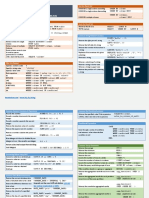0 ratings0% found this document useful (0 votes)
27 viewsChapter Two SQL
The document discusses how to use string, mathematical and date functions in SQL queries to obtain required output. It provides examples of using functions like SUBSTR, CONCAT, LIKE, SUM, AVG, MAX, DATE_FORMAT, DATEDIFF and MONTH.
Uploaded by
SelamCopyright
© © All Rights Reserved
Available Formats
Download as PPTX, PDF, TXT or read online on Scribd
0 ratings0% found this document useful (0 votes)
27 viewsChapter Two SQL
The document discusses how to use string, mathematical and date functions in SQL queries to obtain required output. It provides examples of using functions like SUBSTR, CONCAT, LIKE, SUM, AVG, MAX, DATE_FORMAT, DATEDIFF and MONTH.
Uploaded by
SelamCopyright
© © All Rights Reserved
Available Formats
Download as PPTX, PDF, TXT or read online on Scribd
You are on page 1/ 23
2 )
O (
T W
E R
PT
H A
C
compiled by worku 15/5/23
t h e
i th
s w
t or
e r a e
o p en c
al
c rec e d
e ti
m
h rec t p
i t
r or
g a c
s in
U
compiled by worku 15/5/23
cont
In SQL Server, arithmetic operators also follow
the order of operations, or operator precedence, as
described earlier.
The basic rules of operator precedence in SQL
Server are as follows:
1. Parentheses: expressions inside parentheses are
evaluated first.
compiled by worku 15/5/23
Cont…
. Exponentiation: exponentiation is evaluated next.
3. Multiplication and division: multiplication and
division are evaluated next, from left to right.
4. Addition and subtraction:
Addition and subtraction are evaluated last,
from left to right.
compiled by worku 15/5/23
Cont…
For example, suppose you have the following expression:
SELECT 2 + 3 * 4
According to the order of operations, you should first multiply 3 by 4, and
then add the result to
2. Therefore, the result of the expression would be 14.
If you want to change the order of operations, you can use parentheses to
group expressions together. For example, consider the following expression
SELECT (2 + 3) * 4
compiled by worku 15/5/23
Cont…
In this case, the addition operation inside the parentheses is
evaluated first, giving
5. Then, the multiplication is evaluated, giving a final result of
It's important to be mindful of operator precedence when writing
SQL queries, as it can affect the results of your queries.
If you're unsure about the order of operations, you can always
use parentheses to explicitly group expressions together and
control the order of evaluation.
compiled by worku 15/5/23
Cont…
It's important to be mindful of operator precedence
when writing SQL queries, as it can affect the results
of your queries.
If you're unsure about the order of operations, you
can always use parentheses to explicitly group
expressions together and control the order of
evaluation.
compiled by worku 15/5/23
Using string functions and operators to
obtain required query output
here are a few examples of how to use string
functions and operators in SQL queries to obtain the
required output:
Using the SUBSTR function to extract a portion of a
string:
Suppose you have a table employees with a
column full_name containing full names of employees,
and you want to extract the first name of each employee.
You can use the SUBSTR function along with
the INSTR function to achieve this
compiled by worku 15/5/23
Cont….
SELECT SUBSTR(full_name, 1, INSTR(full_name, ' ') - 1) AS
first_name FROM employees;
n this example, the INSTR function returns the position of the
first space in the full_name column, and then
the SUBSTR function extracts the portion of the string before
the first space, which represents the first name.
Using the CONCAT function to concatenate strings:
Suppose you have a table customers with columns first_name
compiled by worku 15/5/23
Cont…
Suppose you have a table customers with
columns first_name and last_name, and you want to create a new
column that contains the full name of each customer.
You can use the CONCAT function to achieve this:
SELECT CONCAT(first_name, ' ', last_name) AS full_name FROM
customers;
In this example, the CONCAT function concatenates
the first_name column, a space character, and the last_name column to
create a new column full_name.
compiled by worku 15/5/23
Cont…
Using the LIKE operator to search for a specific
pattern in a string:
Suppose you have a table products with a
column product_name, and you want to find all
products that contain the word "chair" in their name.
You can use the LIKE operator along with
the % wildcard character to achieve this:
compiled by worku 15/5/23
Cont…
SELECT * FROM products WHERE
product_name LIKE '%chair%';
In this example, the LIKE operator with
the % wildcard character matches any string
that contains the word "chair" anywhere in
the product_name column.
compiled by worku 15/5/23
Mathematical Functions In SQL
Queries To Obtain The Required Output
how to use mathematical functions in SQL queries to obtain
the required output:
Using the SUM function to calculate the sum of values in a
column:
Suppose you have a table sales with a column sales_amount,
and you want to calculate the total sales amount. You can use
the SUM function to achieve this:
compiled by worku 15/5/23
Cont…
SELECT SUM(sales_amount) AS total_sales FROM sales;
In this example, the SUM function adds up all the values in
the sales_amount column and returns the total as a single
value in a new column named total_sales.
Using the AVG function to calculate the average of values
in a column:
compiled by worku 15/5/23
Cont…
Suppose you have a table employees with a
column salary, and you want to calculate the
average salary of all employees.
You can use the AVG function to achieve this:
SELECT AVG(salary) AS average_salary
FROM employees;
compiled by worku 15/5/23
Cont….
Using the MAX function to find the highest
value in a column:
Suppose you have a table products with a
column price, and you want to find the highest
price of all products.
You can use the MAX function to achieve this:
compiled by worku 15/5/23
Cont…
In this example, the MAX function finds the highest value in
the price column and returns the result as a single value in a
new column named highest_price.
These are just a few examples of how to use mathematical
functions in SQL queries.
There are many other mathematical functions available in
SQL that can be used to perform a wide range of
calculations and obtain the required output.
compiled by worku 15/5/23
use date functions in SQL queries to
obtain the required output:
Using the DATE function to format date values:
Suppose you have a table orders with a
column order_date containing date values in the
format yyyy-mm-dd, and you want to format the
date values to display only the year and month.
You can use the DATE function to achieve this:
compiled by worku 15/5/23
Cont…
SELECT DATE_FORMAT(order_date, '%Y-%m') AS
year_month FROM orders;
In this example, the DATE_FORMAT function formats
the order_date column to display only the year and month in
the format yyyy-mm, and returns the result as a new column
named year_month.
Using the DATEDIFF function to calculate the difference
between two dates:
compiled by worku 15/5/23
Cont…
Suppose you have a table employees with
columns hire_date and termination_date, and you
want to calculate the number of days between the
two dates. You can use the DATEDIFF function to
achieve this:
SELECT DATEDIFF(termination_date, hire_date)
AS employment_duration FROM employees
compiled by worku 15/5/23
Cont…
In this example, the DATEDIFF function
calculates the number of days between
the termination_date and hire_date columns, and
returns the result as a new column
named employment_duration.
Using the MONTH function to extract the month
from a date value:
compiled by worku 15/5/23
Cont…
SELECT MONTH(order_date) AS order_month
FROM orders;
In this example, the MONTH function extracts
the month from each date value in
the order_date column, and returns the result as
a new column named order_month.
compiled by worku 15/5/23
Cont…
These are just a few examples of how to use
date functions in SQL queries.
There are many other date functions available
in SQL that can be used to perform a wide
range of calculations and obtain the required
output.
compiled by worku 15/5/23
You might also like
- Dokumen - Tips Siwes It Report On Web Design100% (3)Dokumen - Tips Siwes It Report On Web Design54 pages
- Data Analysis With SQL: Mysql Cheat SheetNo ratings yetData Analysis With SQL: Mysql Cheat Sheet4 pages
- Database Administration and Management: SQL LabNo ratings yetDatabase Administration and Management: SQL Lab38 pages
- Chaper No.2 Ravindra Babasaheb Nagare DMANo ratings yetChaper No.2 Ravindra Babasaheb Nagare DMA34 pages
- Lab 9 SQL SELECT With Functions, Aggregate FunctionsNo ratings yetLab 9 SQL SELECT With Functions, Aggregate Functions14 pages
- 2025-03-25_11-20-22_Y19Fb0U7jrHKR1Xa8gICKi6qIj0jYZgSjltK5kKRNo ratings yet2025-03-25_11-20-22_Y19Fb0U7jrHKR1Xa8gICKi6qIj0jYZgSjltK5kKR11 pages
- SQL Operators and Functions: BY Ahamed Hashir.MNo ratings yetSQL Operators and Functions: BY Ahamed Hashir.M17 pages
- Data Analysis With SQL: Postgresql Cheat SheetNo ratings yetData Analysis With SQL: Postgresql Cheat Sheet4 pages
- Unit 4 - Usage of Single-Row Functions To Customize OutputNo ratings yetUnit 4 - Usage of Single-Row Functions To Customize Output21 pages
- Standard SQL Functions Cheat Sheet LetterNo ratings yetStandard SQL Functions Cheat Sheet Letter2 pages
- Enhanced Guide To Oracle 10g: Using SQL Queries To Insert, Update, Delete, and View DataNo ratings yetEnhanced Guide To Oracle 10g: Using SQL Queries To Insert, Update, Delete, and View Data41 pages
- Stands For Structural Query Language - Accepted As StandardNo ratings yetStands For Structural Query Language - Accepted As Standard89 pages
- Pivot Tables for everyone. From simple tables to Power-Pivot: Useful guide for creating Pivot Tables in ExcelFrom EverandPivot Tables for everyone. From simple tables to Power-Pivot: Useful guide for creating Pivot Tables in ExcelNo ratings yet
- Develop Website Information ArchitectureNo ratings yetDevelop Website Information Architecture61 pages
- Modelling Website Technical RequirementsNo ratings yetModelling Website Technical Requirements87 pages
- 2024 Calendar Standard With Holidays Portrait Sunday Start en EtNo ratings yet2024 Calendar Standard With Holidays Portrait Sunday Start en Et1 page
- Patient Management Information - SystemNo ratings yetPatient Management Information - System12 pages
- Security Risks and Threats in Cloud Computing: A Comprehensive AnalysisNo ratings yetSecurity Risks and Threats in Cloud Computing: A Comprehensive Analysis6 pages
- My Book Pro Edition II Quick Install GuideNo ratings yetMy Book Pro Edition II Quick Install Guide5 pages
- How To Configure VFD - General - Guides & How-Tos - CoreELEC ForumsNo ratings yetHow To Configure VFD - General - Guides & How-Tos - CoreELEC Forums13 pages
- Smart Editor (A Tool For Fetching and Editing Information)No ratings yetSmart Editor (A Tool For Fetching and Editing Information)2 pages
- jBASE SQL Language: © 2006, 2016 Zumasys, IncNo ratings yetjBASE SQL Language: © 2006, 2016 Zumasys, Inc27 pages
- Exercise 2: Using The Panorama Window: 8 - Chapter 2 Getting Started TutorialsNo ratings yetExercise 2: Using The Panorama Window: 8 - Chapter 2 Getting Started Tutorials2 pages
- FYP Thesis Template Finalized - Updated 15th June 2023No ratings yetFYP Thesis Template Finalized - Updated 15th June 202328 pages
- Lab 9 SQL SELECT With Functions, Aggregate FunctionsLab 9 SQL SELECT With Functions, Aggregate Functions
- 2025-03-25_11-20-22_Y19Fb0U7jrHKR1Xa8gICKi6qIj0jYZgSjltK5kKR2025-03-25_11-20-22_Y19Fb0U7jrHKR1Xa8gICKi6qIj0jYZgSjltK5kKR
- Unit 4 - Usage of Single-Row Functions To Customize OutputUnit 4 - Usage of Single-Row Functions To Customize Output
- Enhanced Guide To Oracle 10g: Using SQL Queries To Insert, Update, Delete, and View DataEnhanced Guide To Oracle 10g: Using SQL Queries To Insert, Update, Delete, and View Data
- Stands For Structural Query Language - Accepted As StandardStands For Structural Query Language - Accepted As Standard
- Pivot Tables for everyone. From simple tables to Power-Pivot: Useful guide for creating Pivot Tables in ExcelFrom EverandPivot Tables for everyone. From simple tables to Power-Pivot: Useful guide for creating Pivot Tables in Excel
- 2024 Calendar Standard With Holidays Portrait Sunday Start en Et2024 Calendar Standard With Holidays Portrait Sunday Start en Et
- Security Risks and Threats in Cloud Computing: A Comprehensive AnalysisSecurity Risks and Threats in Cloud Computing: A Comprehensive Analysis
- How To Configure VFD - General - Guides & How-Tos - CoreELEC ForumsHow To Configure VFD - General - Guides & How-Tos - CoreELEC Forums
- Smart Editor (A Tool For Fetching and Editing Information)Smart Editor (A Tool For Fetching and Editing Information)
- Exercise 2: Using The Panorama Window: 8 - Chapter 2 Getting Started TutorialsExercise 2: Using The Panorama Window: 8 - Chapter 2 Getting Started Tutorials
- FYP Thesis Template Finalized - Updated 15th June 2023FYP Thesis Template Finalized - Updated 15th June 2023




































































































